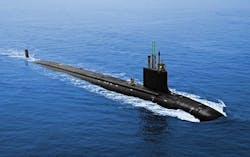Officials of the Naval Sea Systems Command in Washington are asking the Lockheed Martin Rotary and Mission Systems segment in Manassas, Va., for computer hardware, software, and pre-cable kits in the Acoustics-Rapid COTS Insertion (A-RCI) technical insertion (TI) 16 program.
A-RCI TI 16 seeks to provide vast improvements in acoustic sensing aboard U.S. fast-attack, cruise-missile, and ballistic-missile submarines without changing the sonar transducer sensors through the rapid insertion of commercial off-the-shelf (COTS)-based digital signal processing hardware and software.
By making substantial upgrades to ship sensor processing, A-RCI TI 16 will integrate improved sonar processing with existing submarine towed-array, hull-array, and sphere-array sonar arrays.
A-RCI uses a progression of technology insertions to enhance sonar signal processing without altering existing submarine sonar transducers and receivers.
The Lockheed Martin Lockheed Martin Rotary and Mission Systems segment in Manassas, Va. is the A-RCI prime contractor with primary computer equipment supplier Germane Systems in Chantilly, Va.
Naval Sea Systems Command periodically re-competes the A-RCI program to determine if contractors other than Lockheed Martin might be best-suited to the program. Lockheed Martin, in turn, periodically re-competes its A-RCI supplier program to determine if Germane Systems is still the right fit.
An open-systems architecture makes the most of commercial processing development, and enables submarine signal processing systems to use complex algorithms that Navy-developed sonar systems such as the AN/BSY-1 and AN/BSY-2 systems could not use.
Related: Ultra Electronics to provide as many as 50 submarine sonar projectors over next five years
Since 1997 Lockheed Martin sonar experts have been harvesting the most advanced and most promising COTS digital signal processing (DSP) equipment -- from embedded servers, field-programmable gate arrays (FPGAs), to powerful general-purpose processors -- to achieve the most advanced submarine sonar signal processing at the most reasonable cost.
The A-RCI program is among the most visible U.S. military acknowledgements that COTS technology delivers some of the best capability at the most reasonable cost for defense-related embedded digital signal processing technology.
Using COTS technology enables onboard computing power to grow at nearly the same rate as commercial industry, and facilitates regular updates to submarine sonar-processing software and hardware with minimal disruption to submarine scheduling, Navy officials say.
On this order Lockheed Martin will do the work in Manassas, Va., and Clearwater, Fla., and should be finished by December February 2020. For more information contact Lockheed Martin Rotary and Mission Systems online at www.lockheedmartin.com/us/rms.html, or Naval Sea Systems Command at www.navsea.navy.mil.
Ready to make a purchase? Search the Military & Aerospace Electronics Buyer's Guide for companies, new products, press releases, and videos



